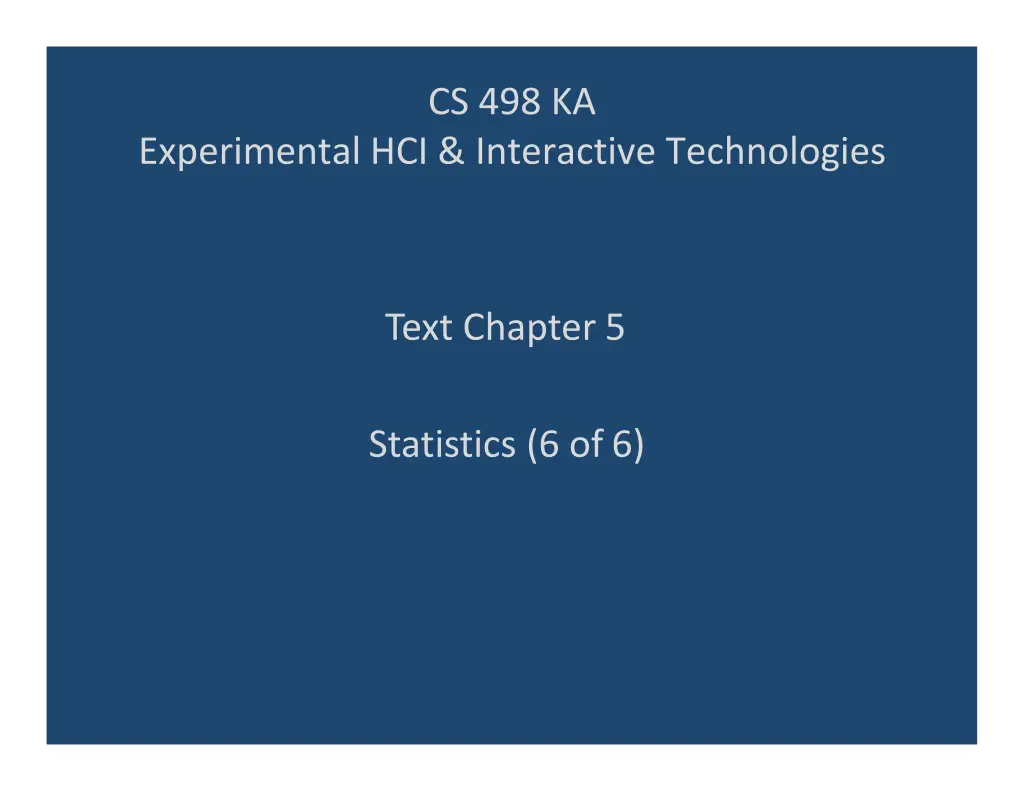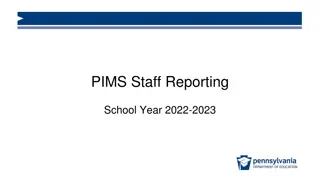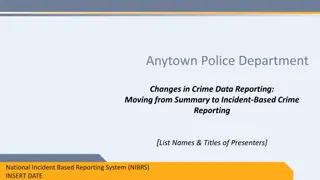
Analysis and Reporting of Experimental HCI Research Findings
Explore the importance of qualitative data analysis in HCI research for identifying outliers, secondary factors, and confounding variables. Understand the significance of statistical analysis in evaluating design decisions and learn to balance statistical and practical significance in research findings.
Download Presentation

Please find below an Image/Link to download the presentation.
The content on the website is provided AS IS for your information and personal use only. It may not be sold, licensed, or shared on other websites without obtaining consent from the author. If you encounter any issues during the download, it is possible that the publisher has removed the file from their server.
You are allowed to download the files provided on this website for personal or commercial use, subject to the condition that they are used lawfully. All files are the property of their respective owners.
The content on the website is provided AS IS for your information and personal use only. It may not be sold, licensed, or shared on other websites without obtaining consent from the author.
E N D
Presentation Transcript
CS 498 KA Experimental HCI & Interactive Technologies Text Chapter 5 Statistics (6 of6)
Statistics (6 of 6) Analysis of Qualitative Data Qualitative data obtained by interview or questionnaire, or by observation of the participants, can help in guiding the analysis by: Identifying potential outliers. For example, a participant who was particularly confused about how to perform the tasks may say so in an interview. It may then be reasonable to eliminate these data. Revealing potentially important secondary factors. For example, if participants said they found one task more difficult than the others, then selective factor analysis can be guided by knowledge of what factors (in this case, the task) might produce interesting results. Revealing possible confounding factors. For example, if some participants reported that the light in the experimental room made it difficult to see the images on the screen in early morning sessions, then a factor analysis could reveal whether the results were affected by the confound.
Statistics (6 of 6) Evaluations It is unlikely that a full statistical analysis will be required for an evaluation that takes place as part of an iterative design cycle. Indeed, the analyses presented in this chapter assume the presence of an independent variable and a comparison between the values of the dependent variables associated with a set of conditions. In the case where the system designers are interested in comparing different binary design decisions then the evaluation may include a comparative method and analysis. It is unlikely, however, that a full and rigorous statistical experiment will be required for such software design decisions. Qualitative feedback from participants can in some cases be more useful than statistical analysis in informing subsequent design decisions.
Statistics (6 of 6) Summary It is easy to let getting statistical significance become the most important goal of your study, and to celebrate when the hard numerical data give you the magic p < .05 value. However, a small significant effect should be treated with caution: if there is a statistically significant difference between the mean error rate of two conditions of 0.03 (say, 0.90 vs. 0.87), then although this shows that condition A may be better than condition B, it is only a small improvement. This may not mean that condition A should always be recommended over B because any gains will be minimal. Similarly, a significant correlation coefficient of 0.15 represents only a small relationship between the two variables (even if it is significant). STATISTICAL and PRACTICAL significance are related, but not identical (!)
CS 498 KA Experimental HCI & Interactive Technologies Text Chapter 6 Reporting Experimental HCI Research in Publications
Reporting Experimental HCI Research in Publications Reviewer s Concerns and Attitudes:
Reporting Experimental HCI Research in Publications Justifying the Research Question and the Experimental Design: First, a case needs to be made as to why the research question you are addressing is important and interesting this is typically done with reference to previous research, experimental or otherwise. Identifying specific prior research that makes a clear case for the question to be addressed is useful. More difficult is the case when the research question arises from ideas spread across different research areas: A clear case needs to be made as to why these areas were worth bringing together and how the research question emerged from a consideration of how they linked together.
Reporting Experimental HCI Research in Publications Justifying the Research Question and the Experimental Design: Typical reviewer comments on the motivation for the research include the authors need to make clearer the case for doing this study, the whole context of the experiment was flawed to begin with, the authors need to reframe this research some other way, combining [two areas of research] into a body of work is not necessarily the only reason to do it, or I am left with one question: So what? Note: It is tremendously easier to respond to such questions when the research is anchored in terms of addressing a socially relevant problem or issue. It is much, much harder to respond to these questions when the research motivation is (essentially), to get another publication.
Reporting Experimental HCI Research in Publications Justifying the Research Method: ALL experimental design decisions need to be justified. That is, the reader needs to know why the experiment has been designed this way and why other possible options were not chosen. This is particularly difficult when there are restrictions on the maximum number of pages allowed for the article because you need to be both comprehensive and succinct. In the (usually rare) case that the method is similar to one that has been previously published, then it may be possible to refer to this prior work as an indirect means of justifying your method. However, this would need to be a popular and well-known experiment, and you would need to be sure that the readers will know about it. Not explaining design decisions leaves you vulnerable to reviewers who are looking for reasons to reject your paper [reasons include that competition for published research pages is a zero-sum game].
Reporting Experimental HCI Research in Publications Justifying the Research Method: It is useful to remember that the experiment is a single point in a multidimensional design space, where each dimension represents a decision that has been made, and that there are many dimensions of choice, including (but not limited to) the following:
Reporting Experimental HCI Research in Publications Justifying the Research Method: Research Dimensions Include:
Reporting Experimental HCI Research in Publications Justifying the Research Method: The choice of experimental objects and tasks will be related to your choice of domain It is common for reviewers to complain that the objects and tasks are too abstract and that the results thus have no real world applicability (e.g., limited generalizability to typical interfaces ). This is a difficult issue to address. In breaking new experimental ground, using an abstract domain in a preliminary experiment enables important experience to be gained before experimenting using real world scenarios, and reviewers need to be persuaded of the importance of an initial (abstract) step in guiding the design of a second (applied) experiment. A clear case therefore needs to be made for an abstract experiment: this may be easier if it is clear that either the results are in a never before- explored area or the experiment and its results are obviously necessary to inform the design of a later real world experiment.
Reporting Experimental HCI Research in Publications Justifying the Research Method: Timing is also a common query, especially if you have chosen to limit the time for each trial, for example, I have trouble understanding why the task completion time needs to be limited to 20 seconds. You would usually have a good reason for limiting the time for the trials: this decision may interact with other decisions and should be explained clearly. Because one reason for limiting the time for each trial is to keep the experiment at a reasonable length, this should be stated, particularly if your timing choices have been based on experiences in pilot experiments. Note: if decisions are practical rather then theoretical, FESS UP!
Reporting Experimental HCI Research in Publications Justifying the Research Method: The nature and number of participants should always be reported, as well as the means of recruiting them. Comments on this issue are sometimes associated with the choice of research question and the experimental objects; for example: The experiment did not include software engineers, which might have different results. In other cases, there may be comments on the nature of the participants (in particular the use of computing science students); for example, The use of a narrow spectrum sample group, although providing an adequate depth to the results, does limit the relevance of results to a small demographic of users, and as such the results cannot be applied to the broader population.
Reporting Experimental HCI Research in Publications Example (Excerpts of an Actual Review of a Journal Article by the Instructor)
Reporting Experimental HCI Research in Publications Example (Excerpts of an Actual Review of a Journal Article by the Instructor)
Reporting Experimental HCI Research in Publications Example (Excerpts of an Actual Review of a Journal Article by the Instructor)
Reporting Experimental HCI Research in Publications Example (Excerpts of an Actual Review of a Journal Article by the Instructor)
Reporting Experimental HCI Research in Publications Example (Excerpts of an Actual Review of a Journal Article by the Instructor)
Reporting Experimental HCI Research in Publications Example (Excerpts of an Actual Review of a Journal Article by the Instructor)
Reporting Experimental HCI Research in Publications Example (Excerpts of an Actual Review of a Journal Article by the Instructor)
Reporting Experimental HCI Research in Publications Example (Excerpts of an Actual Review of a Journal Article by the Instructor)
Reporting Experimental HCI Research in Publications Presenting Results
Reporting Experimental HCI Research in Publications Presenting Results
Reporting Experimental HCI Research in Publications Presenting Results
Reporting Experimental HCI Research in Publications Presenting Results
Reporting Experimental HCI Research in Publications Conclusions versus a Discussion Section
Reporting Experimental HCI Research in Publications Acknowledging Limitations
Reporting Experimental HCI Research in Publications Acknowledging Limitations
Reporting Experimental HCI Research in Publications Summing up your Findings:






















